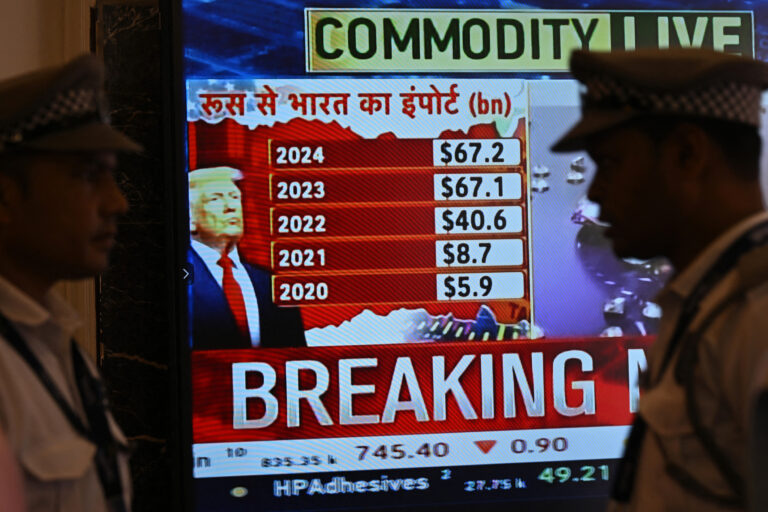President Donald Trump signed an executive order on Thursday imposing tariffs from 10 percent to 41 percent on U.S. imports from dozens of countries and foreign economies.
The tariffs, which will take effect in seven days, include 25 percent on Indian goods entering the U.S., 20 percent on Taiwan’s goods and 30 percent for South Africa’s.
Two of Asia’s poorest countries, Myanmar and Laos, face 40 percent tariffs on their exports to the U.S., while Syria faces the highest rate of 41 percent.
Canada faces tariffs of 35 percent on its exports to the U.S.
In his order, Trump said that some trading partners had agreed or on the verge of agreeing to trade deals “to permanently remedy the trade barriers … and to align with the United States on economic and national security matters.”
“Other trading partners, despite having engaged in negotiations, have offered terms that, in my judgment, do not sufficiently address imbalances in our trading relationship or have failed to align sufficiently with the United States on economic and national-security matters,” he said.
“There are also some trading partners that have failed to engage in negotiations with the United States or to take adequate steps to align sufficiently with the United States on economic and national security matters,” Trump said in the order.

Indranil Mukherjee/Getty Images
Trump set the August 1 deadline after his previous “Liberation Day” tariffs announced in April triggered global market panic fueled by fears of recession. He then imposed a 90-day period for negotiation and further extended the timeline while sending letters that listed rates to world leaders.
That prompted a blizzard of negotiations by numerous countries hoping to reach an agreement before the deadline.
Shortly before the Friday deadline, Trump said he would enter a 90-day negotiating period with Mexico, one of America’s largest trading partners, with the current 25 percent tariff rates staying in place, down from the 30 percent he had threatened earlier.
Higher Tariffs on Canada
For Canada, the tariffs on its U.S.-bound products not covered by the U.S.-Mexico-Canada trade agreement will rise to 35 percent from 25 percent, the White House said, as the Trump administration blamed the higher tariffs on the smuggling of fentanyl over the northern border.
“Canada has failed to cooperate in curbing the ongoing flood of fentanyl and other illicit drugs, and it has retaliated against the United States for the President’s actions to address this unusual and extraordinary threat to the United States,” the White House said in a statement.
Canada rebukes this, saying only tiny amounts of the drug are smuggled into the United States over their common border.
Trump has earlier said that Canada’s support for a Palestinian state would make any trade deal between Washington and Ottawa “very hard.” Canadian Prime Minister Mark Carney announced that Canada was planning to recognize a Palestinian state at the United Nations in September.
Trump said that Carney had called before the announcement of 35 percent tariffs on many of his nation’s goods, but that “we haven’t spoken to Canada today.”
Deals Done
Among the countries to strike last-minute deals was South Korea, which will face a 15 percent tariff on its exports to the United States.
Trump announced a framework deal with Japan on July 22, including a 15 percent tariff on Japanese goods, down from a threatened rate of 25 percent. The president also said Japan would invest $550 billion into the U.S. and “open” its economy to American autos and rice.
The U.S. and EU announced a deal on July 27 that includes a 15 percent tariff on 70 percent of EU goods entering the U.S., down from a threatened 30 percent.
Trade officials from the U.S. and China, Asia’s largest economy and the world’s second-largest, met for two days in Stockholm this week after which China’s top trade official said the two sides had agreed to work on extending an August 12 deadline.
Trump’s tariffs on Chinese goods previously totaled 145 percent and China’s counter-tariffs on U.S. products reached 125 percent, raising the prospect of a damaging trade war. But on May 12, the sides agreed to a 90-day truce to roll back those levies to 30 percent and 10 percent, respectively.
Under a deal announced on May 8, the U.K. will face a 10 percent baseline tariff on its goods while Trump agreed to cut tariffs on British autos, steel and aluminum, among other pledges. The U.K. promised to reduce levies on U.S. products like olive oil, wine and sports equipment.
A deal with the Philippines announced on July 22 includes a 19 percent tariff. Under a July 15 agreement with Indonesia, its goods will face a 19 percent tariff. Vietnamese goods will face a 20 percent U.S. tariff under a deal announced on July 2. U.S. goods will enter Vietnam duty free.
Reporting by the Associated Press contributed to this article.


